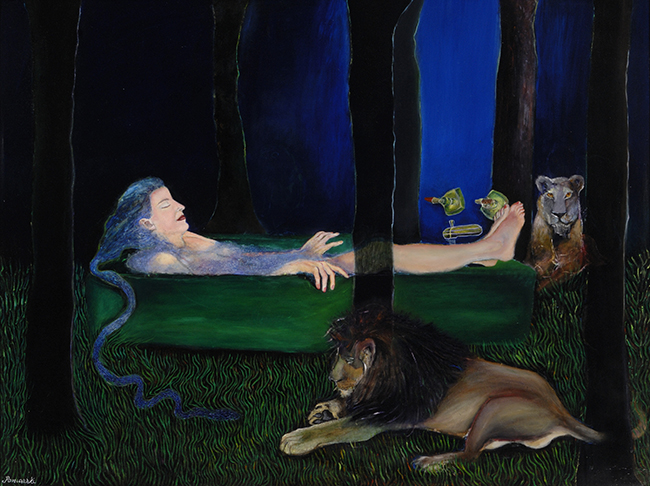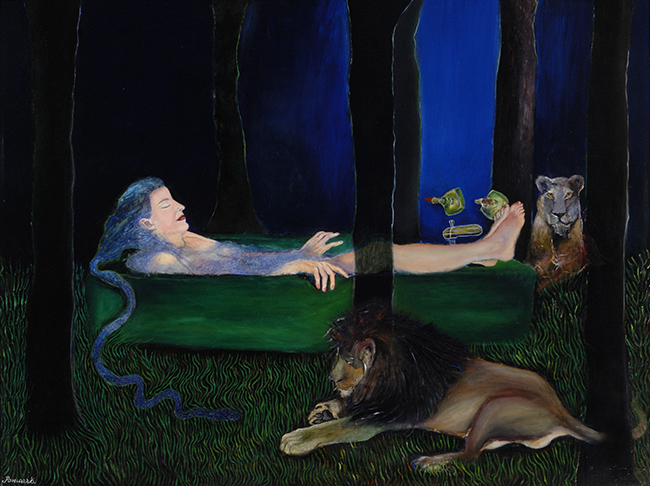Ruth Poniarski’s story is one of transformation. After earning her Bachelor of Architecture from Pratt Institute in 1982, she spent ten years working in the construction world. Yet something else was calling her. In 1988, she turned to painting—a move that opened new channels of imagination and emotional expression. Where architecture demanded precision and structure, painting offered Poniarski a space to explore freely, blending myths, culture, philosophy, and literature into a style that feels deeply personal.
By 1995, she added another layer to her work: poetry. Each of her paintings gained a corresponding poem, pulling viewers deeper into her vision. Together, her visual and literary expressions create a world where symbolic storytelling thrives, and where viewers are invited not just to look, but to enter.

The Work: The Bather
In The Bather, Ruth Poniarski brings her signature surrealism to life on a large acrylic canvas, measuring 40″ x 60″. At first glance, the scene appears calm: water filling the bath walls, held in place, seemingly timeless. But look closer, and tension starts to rise.
The poem paired with the painting sets the tone:
“The water held within the wells of the bath walls
in supply of the garden cord
with intensifying devotion
endorsing a love
purer than the moment before”
The imagery feels lush but restrained. The bath, often a symbol of purity or rebirth, becomes a vessel of devotion here. It’s as if the water itself holds memory—of love, of time, of transformation. This opening passage frames the painting not just as a visual object, but as a story suspended between moments.
Then come the animals: the hare, the snake, and the lion. Each carries mythological weight. The hare suggests swiftness or vulnerability, the snake transformation and rebirth, and the lion courage or power. Poniarski stages a quiet drama where these figures pull the lion into a “cave of continuum,” a place she describes as containing both darkness and light.
There’s a tension here that’s subtle but real. Light and darkness exist together. Curiosity meets need. The cave is a space of change, and so is the bath. Both are thresholds—places where old selves dissolve and new ones emerge.
“I learn of curiosity and need ( the forces of change )
in the restoration of my dream
And the departure from liquid reality.”
By the poem’s end, it’s clear that The Bather is about more than just cleansing. It’s about a surrender to change. Liquid reality—fluid, unstable—gives way to something different, perhaps something more solid or at least more self-aware. The painting and the poem work together to make this shift tangible, without forcing a clear narrative. Poniarski lets the viewer find their own meaning.
Stylistically, The Bather fits within her broader body of work. Her paintings are dreamlike but never lose a sense of structure—a reflection, perhaps, of her architectural roots. Colors might bend reality, figures might defy logic, but there’s always a sense that these surreal spaces could exist somewhere, if only on the edge of waking life.
The combination of painting and poetry feels natural in her work. Instead of simply illustrating ideas, she builds layered experiences. You can read the poem aloud while studying the painting and feel how they echo each other, deepening the experience.
Poniarski’s art asks for patience. It asks you to sit with it, to turn the images and words over in your mind, letting new interpretations surface. Just as The Bather portrays a movement from one state to another, her paintings invite viewers to undergo their own quiet transformations.
In the end, Poniarski’s work feels less like a static product and more like a living dialogue. It holds space for myth, for memory, for the contradictions between light and dark, devotion and change. The Bather captures all of this in a single, vivid moment—one that continues to ripple outward long after you step away.


